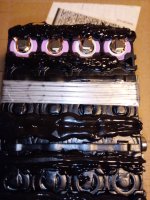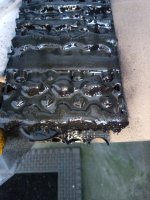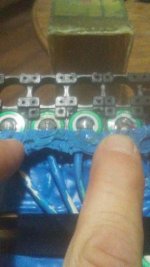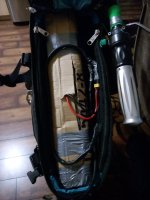You are using an out of date browser. It may not display this or other websites correctly.
You should upgrade or use an alternative browser.
You should upgrade or use an alternative browser.
40T, neodymium magnets, plasti dip cycle test
- Thread starter goatman
- Start date
goatman
10 MW
need to finish a battery
have scrap nickel strip
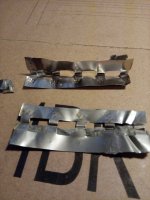
wrong dimension
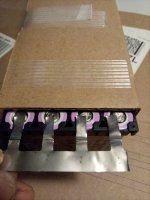
time to mickey mouse it
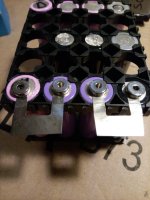
1/8 x 3/8 magnets are strong
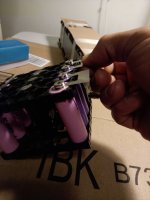
10mmx1mm not so much
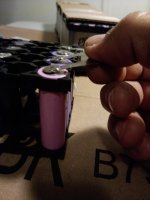
10mm x 1mm will hold the cell at this angle
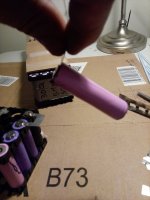
trace onto foil
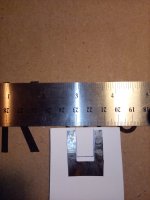
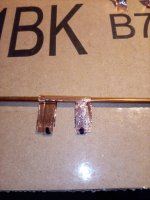
shouldve made all like this

10 gauge
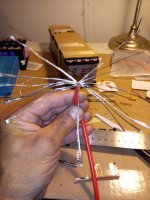
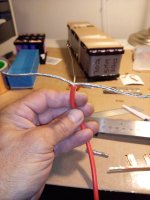
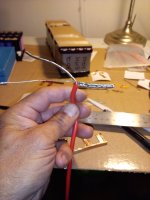
twist crimped with 20 gauge
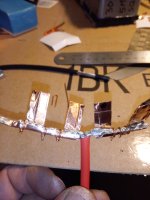
dont really like that, want more contact for amps, decided to wrap with copper strand

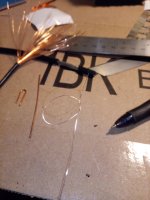
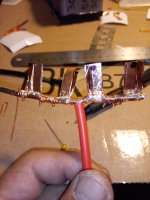
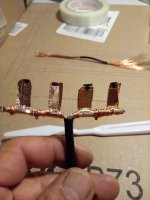
using 7.5mm magnets and a 10mm to help keep everything in place while i caulk it in place

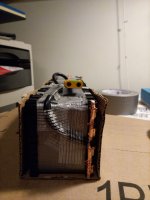
have scrap nickel strip

wrong dimension

time to mickey mouse it

1/8 x 3/8 magnets are strong

10mmx1mm not so much

10mm x 1mm will hold the cell at this angle

trace onto foil


shouldve made all like this

10 gauge



twist crimped with 20 gauge

dont really like that, want more contact for amps, decided to wrap with copper strand




using 7.5mm magnets and a 10mm to help keep everything in place while i caulk it in place


Pajda
10 kW
I must say that I like to follow your inventive approach 
goatman
10 MW
ya  amazon lost my 0.1mm copper in shipping and im moving June.01 so i didnt want to order anything til end of the month
amazon lost my 0.1mm copper in shipping and im moving June.01 so i didnt want to order anything til end of the month
im low on everything, magnets, cell holders, big battery wrap, 18 pin connectors....
in the meantime. the nickel is 0.15mm and 3 layers of foil is about 0.1mm for total of 0.25mm
5mm square magnet has 0.6lbs pull at 0.1mm
https://www.indigoinstruments.com/magnets/rare_earth/blocks/ndfeb-square-thin-magnets-5x5x1mm-44222-1.html
to equal the pull of 1-10mm magnet 1.2 lb pull
i used 1-7.5mm ring and 1-5mm square, 1.4lb pull
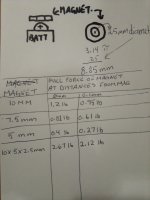

time for plast dip
im low on everything, magnets, cell holders, big battery wrap, 18 pin connectors....
in the meantime. the nickel is 0.15mm and 3 layers of foil is about 0.1mm for total of 0.25mm
5mm square magnet has 0.6lbs pull at 0.1mm
https://www.indigoinstruments.com/magnets/rare_earth/blocks/ndfeb-square-thin-magnets-5x5x1mm-44222-1.html
to equal the pull of 1-10mm magnet 1.2 lb pull
i used 1-7.5mm ring and 1-5mm square, 1.4lb pull


time for plast dip
Ianhill
1 MW
- Joined
- Sep 25, 2015
- Messages
- 2,871
Thats perseverance for you got there in the end.
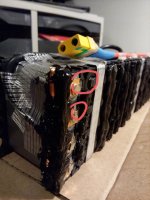
Only one bit i spot is that little overhang would be ideally rounded on the corners so it stays within the tabs boundarys to guarantee no foul play later on but otherwise that a real nice bit of progress you got by there and looking forward to seeing how it performs thermally under load i think it should do quite well.

Only one bit i spot is that little overhang would be ideally rounded on the corners so it stays within the tabs boundarys to guarantee no foul play later on but otherwise that a real nice bit of progress you got by there and looking forward to seeing how it performs thermally under load i think it should do quite well.
goatman
10 MW
Hummina Shadeeba
1 MW
How does potting effect the safety release valves on cells? I don’t know how but the A123 26650 cells will somehow disconnect when shorted for long enough and then magically come back. (Current will drop drastically but same voltage somehow, then later string current). It’s a pretty safe cell to begin with but what if u jam up the pid or whatever it’s called on some other cells? Maybe be a fun experiment
If going for maximum pull with small magnets maybe worth adding a back iron. Cheaper than a bigger magnet.
If going for maximum pull with small magnets maybe worth adding a back iron. Cheaper than a bigger magnet.
goatman
10 MW
dont need back iron, theres enough in the can
bigger/heavier the magnet, the more lbs of pull required to keep the weight of the magnet in place
been trying to go as small and light as possible
7.5mm magnets with 0.1mm copper ill do a test when i get it to see how many amps it can do before the connection goes bad
7.5 mm magnets and foil will do 15amps, i run those on the trike at 7amps max with no issues
my 14 gauge battery leads were warmer than the batteries so im switching everything to 10awg
im putting this 5mm magnet battery build in the trike because they can handle 7 amps and putting the 7.5mm magnet battery build in the other bike because they can do 15 amps
i just dont know how the smoothness of 0.1mm copper will effect the connection but thats what i want to use for the terminal connections
theres no shorting out happening, plasti dip is an electrical insulator, i used the pour on plasti dip that comes in a can and covered the whole side of a 17s battery, i was kind of nervous thinking it might short out and blow up but nothing happened
as far as blowing up, im using 30Qs and 25Rs i havent seen them blow up from shorting them out
30Q
https://www.youtube.com/watch?v=Ys5wwUJOz58
25r
https://www.youtube.com/watch?v=oBlac5gWLfI
bigger/heavier the magnet, the more lbs of pull required to keep the weight of the magnet in place
been trying to go as small and light as possible
7.5mm magnets with 0.1mm copper ill do a test when i get it to see how many amps it can do before the connection goes bad
7.5 mm magnets and foil will do 15amps, i run those on the trike at 7amps max with no issues
my 14 gauge battery leads were warmer than the batteries so im switching everything to 10awg
im putting this 5mm magnet battery build in the trike because they can handle 7 amps and putting the 7.5mm magnet battery build in the other bike because they can do 15 amps
i just dont know how the smoothness of 0.1mm copper will effect the connection but thats what i want to use for the terminal connections
theres no shorting out happening, plasti dip is an electrical insulator, i used the pour on plasti dip that comes in a can and covered the whole side of a 17s battery, i was kind of nervous thinking it might short out and blow up but nothing happened
as far as blowing up, im using 30Qs and 25Rs i havent seen them blow up from shorting them out
30Q
https://www.youtube.com/watch?v=Ys5wwUJOz58
25r
https://www.youtube.com/watch?v=oBlac5gWLfI
That's unconventional and probably why I like it. Strapped on well, I would think it should work fine. :thumb:
Ianhill
1 MW
- Joined
- Sep 25, 2015
- Messages
- 2,871
Back iron on the rear of the magnet would guide the field lines on the reverse to give a higher surface tesla on the magnet  so it should increase pull strength.
so it should increase pull strength.
I wonder if theres small enough magnets available to create a hallbach array no back iton needed it could double the pull to the cell and have less than half the field strength away from the pack where its not needed.
I wonder if theres small enough magnets available to create a hallbach array no back iton needed it could double the pull to the cell and have less than half the field strength away from the pack where its not needed.
goatman
10 MW
Ianhill said:Back iron on the rear of the magnet would guide the field lines on the reverse to give a higher surface tesla on the magnetso it should increase pull strength.
I wonder if theres small enough magnets available to create a hallbach array no back iton needed it could double the pull to the cell and have less than half the field strength away from the pack where its not needed.
you guys lost me, had to go google back iron and hallback array.
try to figure it out later
MorbidlyObeseKoala
100 W
- Joined
- Apr 6, 2018
- Messages
- 146
Wouldn't a back iron also provide a short path for current for the whole battery? Or was the idea to place that back iron over the layered plastidip?
A pull strength test might be interesting to compare crappy spot welds to the magnets but if goatman is getting repeatable amperage results, then this seems to be a novel approach with no specialized tools to me. My limited experience with plastidip on my car, I would say monitor it after a year or so for any flakes or tears. Tends to dry out and be painful to remove in one piece when it's fresh.
Just have to make sure your scissors or crap from the messy workbench don't get pulled into the magnets and short the whole thing out before you get it dipped.
A pull strength test might be interesting to compare crappy spot welds to the magnets but if goatman is getting repeatable amperage results, then this seems to be a novel approach with no specialized tools to me. My limited experience with plastidip on my car, I would say monitor it after a year or so for any flakes or tears. Tends to dry out and be painful to remove in one piece when it's fresh.
Just have to make sure your scissors or crap from the messy workbench don't get pulled into the magnets and short the whole thing out before you get it dipped.
goatman
10 MW
Ianhill
1 MW
- Joined
- Sep 25, 2015
- Messages
- 2,871
Back iron in this case could be as simple as a metal button sat on top of each magnet so it wouldn't be part of the electrical circuit only magnetic.
Ive had a look for some small magnets that might be suitable to make an array but theres no chance from what i can find anything small enough.
Ive had a look for some small magnets that might be suitable to make an array but theres no chance from what i can find anything small enough.
I've been using these on cabinet doors for years.
https://www.leevalley.com/en-us/shop/hardware/rare-earth-magnets/magnets/disc/58750-rare-earth-magnet-cup-and-washer-sets
Canadian company too.
https://www.leevalley.com/en-us/shop/hardware/rare-earth-magnets/magnets/disc/58750-rare-earth-magnet-cup-and-washer-sets
Canadian company too.
goatman
10 MW
took that 5mm pack to the hill i test the batteries on and pulled 47amps (almost 12 amps/cell) no problems then paralleled to the 7.5mm battery went for a 8km ride. the trike is set to 3000 watts, 8p means less volt sag so the max amps were 44 (5.5amps) packs were the same temp and no issues
goatman
10 MW
Hummina Shadeeba
1 MW
It seems with the magnets you don’t have to worry about rough riding stressing connections, and the rubber holding it all in place is nice.
You could get the least resistance of any connections I’d think. I guess you didn’t get a precision resistance meter for the battery and I didn’t read about comparing it to other packs or how it ages which would be nice.
You could get the least resistance of any connections I’d think. I guess you didn’t get a precision resistance meter for the battery and I didn’t read about comparing it to other packs or how it ages which would be nice.
goatman
10 MW
the ca3 shows resistance but i dont know what its measuring
my load tester shows resistance but i dont know what its measuring
i could hook up my 25r pack that was spot welded then i soldered 14 gauge copper wire to all the series connections and compare to the 30Q but i dont think that will prove anything its just different cells
i have those pics somewhere here
someone would have to spotweld 2 new cells in series with nickel and do a test and do the same with another 2 new cells in series with the copper, i dont have a spotwelder
my load tester shows resistance but i dont know what its measuring
i could hook up my 25r pack that was spot welded then i soldered 14 gauge copper wire to all the series connections and compare to the 30Q but i dont think that will prove anything its just different cells
i have those pics somewhere here
someone would have to spotweld 2 new cells in series with nickel and do a test and do the same with another 2 new cells in series with the copper, i dont have a spotwelder
goatman
10 MW
copper came in
https://www.amazon.ca/YHcXm-Copper-Flashing-Length-Thickness/dp/B085VZZDGJ/ref=sr_1_2?dchild=1&keywords=soft+copper+sheet+flashing+16.4&qid=1623635498&sr=8-2
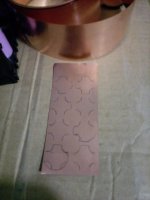
if someone sold it precut like this with the 7.5mm magnets, you could build a pack in less than 30 minutes
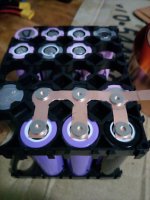
quick, clean, low profile
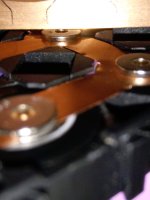
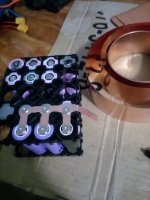
picking up a 3d printer next
would be nice to be able screw the pack together
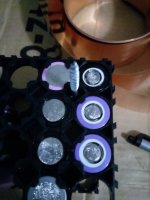
but some machine screws would work with pan head screws and nuts recessed in that spot where that screw is sticking up
https://www.amazon.ca/YHcXm-Copper-Flashing-Length-Thickness/dp/B085VZZDGJ/ref=sr_1_2?dchild=1&keywords=soft+copper+sheet+flashing+16.4&qid=1623635498&sr=8-2

if someone sold it precut like this with the 7.5mm magnets, you could build a pack in less than 30 minutes

quick, clean, low profile


picking up a 3d printer next
would be nice to be able screw the pack together

but some machine screws would work with pan head screws and nuts recessed in that spot where that screw is sticking up
Hummina Shadeeba
1 MW
Be nice to get the copper stamped or something. Looks nice except the sharp corners. Rather trim it to the shape of the magnet
Really interested by your approach to a solderless pack! I'd just have some questions on things I may have missed in the thread:
- You're using 7.5mm diameter magnets on 21700 cells, right? Could you precise what's the thickness of the magnets? Why not 10mm diameter magnets on 21700 cells?
- what magnet size were you using on 18650 cells previously?
- The new copper foil you're getting is 0.1mm thick but it was already going well with 0.05mm copper tape? Do you see any pull difference from the magnets between 0.05mm and 0.1mm copper?
- This has probably been asked before but what about oxydation of the copper? Is that a non-issue if the pack is plasti-dipped? What about using a tin plated copper tape such as 3M 1345:
https://multimedia.3m.com/mws/media...ing-tape-1345-data-sheet-78-8124-4709-8-d.pdf
Copper layer is only 0.036mm thick so maybe not enough but I guess there are other thicknesses. Would that be a good thing to prevent oxydation of the copper?
Thanks!
- You're using 7.5mm diameter magnets on 21700 cells, right? Could you precise what's the thickness of the magnets? Why not 10mm diameter magnets on 21700 cells?
- what magnet size were you using on 18650 cells previously?
- The new copper foil you're getting is 0.1mm thick but it was already going well with 0.05mm copper tape? Do you see any pull difference from the magnets between 0.05mm and 0.1mm copper?
- This has probably been asked before but what about oxydation of the copper? Is that a non-issue if the pack is plasti-dipped? What about using a tin plated copper tape such as 3M 1345:
https://multimedia.3m.com/mws/media...ing-tape-1345-data-sheet-78-8124-4709-8-d.pdf
Copper layer is only 0.036mm thick so maybe not enough but I guess there are other thicknesses. Would that be a good thing to prevent oxydation of the copper?
Thanks!
goatman
10 MW
im using the 7.5mm ring magnets on 18650 cells, theyre 1mm thick
the positive button is 8mm diameter, if you use 10mm magnets on 18650, the magnet wants to pull to the outside negative ring
10mm is good for 21700 :thumb:
the copper slug tape is really only about 0.03mm thick, its time consuming to make the magnets
was looking for a faster build process and you still need to do the parallel connection/bms lead
5mm magnets with slug tape, is fine. magnets cost half as much as 10mm but takes 8x longer to build a pack
liquid tape is approved for electrical connections in marine environments and they make plasti dip, i figure its the same stuff, different can
the positive button is 8mm diameter, if you use 10mm magnets on 18650, the magnet wants to pull to the outside negative ring
10mm is good for 21700 :thumb:
the copper slug tape is really only about 0.03mm thick, its time consuming to make the magnets
was looking for a faster build process and you still need to do the parallel connection/bms lead
5mm magnets with slug tape, is fine. magnets cost half as much as 10mm but takes 8x longer to build a pack
liquid tape is approved for electrical connections in marine environments and they make plasti dip, i figure its the same stuff, different can
Great, thanks! I didn't know you were using 1mm thick magnets. Thought it would require at least 3mm to provide sufficient pull. But that's great to know that 1mm is enough (hope it's still good with your 0.1mm thick copper plate). Do you also use 1mm thick magnets for 21700 cells?
Regarding oxydation, when plastidipping your pack, you're only covering one side of the copper plate. The side that rest against the cells and which makes contact with them is not covered with plastidip. So oxydation could still occur there, due to air being trapped between the cells (+temperature changes inducing some condensation maybe). It's this side of the copper plate that matter most since it's where the electrical contact with the cells occur. Don't you think that a tin plated copper plate would be better in that respect?
Regarding oxydation, when plastidipping your pack, you're only covering one side of the copper plate. The side that rest against the cells and which makes contact with them is not covered with plastidip. So oxydation could still occur there, due to air being trapped between the cells (+temperature changes inducing some condensation maybe). It's this side of the copper plate that matter most since it's where the electrical contact with the cells occur. Don't you think that a tin plated copper plate would be better in that respect?
Hummina Shadeeba
1 MW
How quickly will oxidize depends on the environment of course but what I have laying around my house looks good after years.
Electroplating on nickel is pretty easy
maybe a tiny dab of conductive paste on the cell where it contacts or maybe that would inhibit the cure of the resin.
Electroplating on nickel is pretty easy
maybe a tiny dab of conductive paste on the cell where it contacts or maybe that would inhibit the cure of the resin.
Similar threads
- Replies
- 3
- Views
- 757
- Replies
- 13
- Views
- 4,324
- Replies
- 1
- Views
- 2,475
- Replies
- 15
- Views
- 2,825


